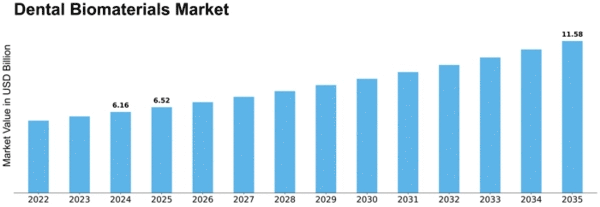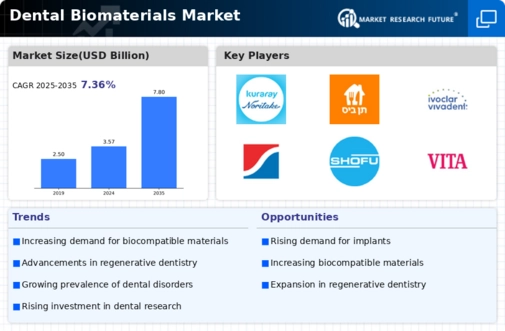-
EXECUTIVE SUMMARY
-
Market Overview
-
Key Findings
-
Market Segmentation
-
Competitive Landscape
-
Challenges and Opportunities
-
Future Outlook
-
MARKET INTRODUCTION
-
Definition
-
Scope of the study
-
Research Objective
-
Assumption
-
Limitations
-
RESEARCH METHODOLOGY
-
Overview
-
Data Mining
-
Secondary Research
-
Primary Research
-
Primary Interviews and Information Gathering Process
-
Breakdown of Primary Respondents
-
Forecasting Model
-
Market Size Estimation
-
Bottom-Up Approach
-
Top-Down Approach
-
Data Triangulation
-
Validation
-
MARKET DYNAMICS
-
Overview
-
Drivers
-
Restraints
-
Opportunities
-
MARKET FACTOR ANALYSIS
-
Value chain Analysis
-
Porter's Five Forces Analysis
-
Bargaining Power of Suppliers
-
Bargaining Power of Buyers
-
Threat of New Entrants
-
Threat of Substitutes
-
Intensity of Rivalry
-
COVID-19 Impact Analysis
-
Market Impact Analysis
-
Regional Impact
-
Opportunity and Threat Analysis
-
Dental Biomaterials Market, BY Material Type (USD Billion)
-
Ceramics
-
Polymers
-
Metals
-
Composites
-
Dental Biomaterials Market, BY Application (USD Billion)
-
Dentistry Implants
-
Restorative Dentistry
-
Orthodontics
-
Endodontics
-
Dental Biomaterials Market, BY End Use (USD Billion)
-
Hospitals
-
Dental Clinics
-
Research Laboratories
-
Dental Biomaterials Market, BY Product Form (USD Billion)
-
Consumables
-
Equipment
-
Implants
-
Dental Biomaterials Market, BY Regional (USD Billion)
-
North America
-
US
-
Canada
-
Europe
-
Germany
-
UK
-
France
-
Russia
-
Italy
-
Spain
-
Rest of Europe
-
APAC
-
China
-
India
-
Japan
-
South Korea
-
Malaysia
-
Thailand
-
Indonesia
-
Rest of APAC
-
South America
-
Brazil
-
Mexico
-
Argentina
-
Rest of South America
-
MEA
-
GCC Countries
-
South Africa
-
Rest of MEA
-
Competitive Landscape
-
Overview
-
Competitive Analysis
-
Market share Analysis
-
Major Growth Strategy in the Dental Biomaterials Market
-
Competitive Benchmarking
-
Leading Players in Terms of Number of Developments in the Dental Biomaterials Market
-
Key developments and growth strategies
-
New Product Launch/Service Deployment
-
Merger & Acquisitions
-
Joint Ventures
-
Major Players Financial Matrix
-
Sales and Operating Income
-
Major Players R&D Expenditure. 2023
-
Company Profiles
-
Zimmer Biomet
-
Financial Overview
-
Products Offered
-
Key Developments
-
SWOT Analysis
-
Key Strategies
-
MediFear
-
Financial Overview
-
Products Offered
-
Key Developments
-
SWOT Analysis
-
Key Strategies
-
Straumann
-
Financial Overview
-
Products Offered
-
Key Developments
-
SWOT Analysis
-
Key Strategies
-
GC Corporation
-
Financial Overview
-
Products Offered
-
Key Developments
-
SWOT Analysis
-
Key Strategies
-
Regent Dental
-
Financial Overview
-
Products Offered
-
Key Developments
-
SWOT Analysis
-
Key Strategies
-
Bisco
-
Financial Overview
-
Products Offered
-
Key Developments
-
SWOT Analysis
-
Key Strategies
-
Dentsply Sirona
-
Financial Overview
-
Products Offered
-
Key Developments
-
SWOT Analysis
-
Key Strategies
-
Kavo Kerr
-
Financial Overview
-
Products Offered
-
Key Developments
-
SWOT Analysis
-
Key Strategies
-
BioHorizons
-
Financial Overview
-
Products Offered
-
Key Developments
-
SWOT Analysis
-
Key Strategies
-
Henry Schein
-
Financial Overview
-
Products Offered
-
Key Developments
-
SWOT Analysis
-
Key Strategies
-
Mitsui Chemicals
-
Financial Overview
-
Products Offered
-
Key Developments
-
SWOT Analysis
-
Key Strategies
-
Nobel Biocare
-
Financial Overview
-
Products Offered
-
Key Developments
-
SWOT Analysis
-
Key Strategies
-
Heraeus
-
Financial Overview
-
Products Offered
-
Key Developments
-
SWOT Analysis
-
Key Strategies
-
Coltene
-
Financial Overview
-
Products Offered
-
Key Developments
-
SWOT Analysis
-
Key Strategies
-
3M
-
Financial Overview
-
Products Offered
-
Key Developments
-
SWOT Analysis
-
Key Strategies
-
Appendix
-
References
-
Related Reports
-
LIST Of tables
-
LIST OF ASSUMPTIONS
-
North America Dental Biomaterials Market SIZE ESTIMATES & FORECAST, BY MATERIAL TYPE, 2019-2035 (USD Billions)
-
North America Dental Biomaterials Market SIZE ESTIMATES & FORECAST, BY APPLICATION, 2019-2035 (USD Billions)
-
North America Dental Biomaterials Market SIZE ESTIMATES & FORECAST, BY END USE, 2019-2035 (USD Billions)
-
North America Dental Biomaterials Market SIZE ESTIMATES & FORECAST, BY PRODUCT FORM, 2019-2035 (USD Billions)
-
North America Dental Biomaterials Market SIZE ESTIMATES & FORECAST, BY REGIONAL, 2019-2035 (USD Billions)
-
US Dental Biomaterials Market SIZE ESTIMATES & FORECAST, BY MATERIAL TYPE, 2019-2035 (USD Billions)
-
US Dental Biomaterials Market SIZE ESTIMATES & FORECAST, BY APPLICATION, 2019-2035 (USD Billions)
-
US Dental Biomaterials Market SIZE ESTIMATES & FORECAST, BY END USE, 2019-2035 (USD Billions)
-
US Dental Biomaterials Market SIZE ESTIMATES & FORECAST, BY PRODUCT FORM, 2019-2035 (USD Billions)
-
US Dental Biomaterials Market SIZE ESTIMATES & FORECAST, BY REGIONAL, 2019-2035 (USD Billions)
-
Canada Dental Biomaterials Market SIZE ESTIMATES & FORECAST, BY MATERIAL TYPE, 2019-2035 (USD Billions)
-
Canada Dental Biomaterials Market SIZE ESTIMATES & FORECAST, BY APPLICATION, 2019-2035 (USD Billions)
-
Canada Dental Biomaterials Market SIZE ESTIMATES & FORECAST, BY END USE, 2019-2035 (USD Billions)
-
Canada Dental Biomaterials Market SIZE ESTIMATES & FORECAST, BY PRODUCT FORM, 2019-2035 (USD Billions)
-
Canada Dental Biomaterials Market SIZE ESTIMATES & FORECAST, BY REGIONAL, 2019-2035 (USD Billions)
-
Europe Dental Biomaterials Market SIZE ESTIMATES & FORECAST, BY MATERIAL TYPE, 2019-2035 (USD Billions)
-
Europe Dental Biomaterials Market SIZE ESTIMATES & FORECAST, BY APPLICATION, 2019-2035 (USD Billions)
-
Europe Dental Biomaterials Market SIZE ESTIMATES & FORECAST, BY END USE, 2019-2035 (USD Billions)
-
Europe Dental Biomaterials Market SIZE ESTIMATES & FORECAST, BY PRODUCT FORM, 2019-2035 (USD Billions)
-
Europe Dental Biomaterials Market SIZE ESTIMATES & FORECAST, BY REGIONAL, 2019-2035 (USD Billions)
-
Germany Dental Biomaterials Market SIZE ESTIMATES & FORECAST, BY MATERIAL TYPE, 2019-2035 (USD Billions)
-
Germany Dental Biomaterials Market SIZE ESTIMATES & FORECAST, BY APPLICATION, 2019-2035 (USD Billions)
-
Germany Dental Biomaterials Market SIZE ESTIMATES & FORECAST, BY END USE, 2019-2035 (USD Billions)
-
Germany Dental Biomaterials Market SIZE ESTIMATES & FORECAST, BY PRODUCT FORM, 2019-2035 (USD Billions)
-
Germany Dental Biomaterials Market SIZE ESTIMATES & FORECAST, BY REGIONAL, 2019-2035 (USD Billions)
-
UK Dental Biomaterials Market SIZE ESTIMATES & FORECAST, BY MATERIAL TYPE, 2019-2035 (USD Billions)
-
UK Dental Biomaterials Market SIZE ESTIMATES & FORECAST, BY APPLICATION, 2019-2035 (USD Billions)
-
UK Dental Biomaterials Market SIZE ESTIMATES & FORECAST, BY END USE, 2019-2035 (USD Billions)
-
UK Dental Biomaterials Market SIZE ESTIMATES & FORECAST, BY PRODUCT FORM, 2019-2035 (USD Billions)
-
UK Dental Biomaterials Market SIZE ESTIMATES & FORECAST, BY REGIONAL, 2019-2035 (USD Billions)
-
France Dental Biomaterials Market SIZE ESTIMATES & FORECAST, BY MATERIAL TYPE, 2019-2035 (USD Billions)
-
France Dental Biomaterials Market SIZE ESTIMATES & FORECAST, BY APPLICATION, 2019-2035 (USD Billions)
-
France Dental Biomaterials Market SIZE ESTIMATES & FORECAST, BY END USE, 2019-2035 (USD Billions)
-
France Dental Biomaterials Market SIZE ESTIMATES & FORECAST, BY PRODUCT FORM, 2019-2035 (USD Billions)
-
France Dental Biomaterials Market SIZE ESTIMATES & FORECAST, BY REGIONAL, 2019-2035 (USD Billions)
-
Russia Dental Biomaterials Market SIZE ESTIMATES & FORECAST, BY MATERIAL TYPE, 2019-2035 (USD Billions)
-
Russia Dental Biomaterials Market SIZE ESTIMATES & FORECAST, BY APPLICATION, 2019-2035 (USD Billions)
-
Russia Dental Biomaterials Market SIZE ESTIMATES & FORECAST, BY END USE, 2019-2035 (USD Billions)
-
Russia Dental Biomaterials Market SIZE ESTIMATES & FORECAST, BY PRODUCT FORM, 2019-2035 (USD Billions)
-
Russia Dental Biomaterials Market SIZE ESTIMATES & FORECAST, BY REGIONAL, 2019-2035 (USD Billions)
-
Italy Dental Biomaterials Market SIZE ESTIMATES & FORECAST, BY MATERIAL TYPE, 2019-2035 (USD Billions)
-
Italy Dental Biomaterials Market SIZE ESTIMATES & FORECAST, BY APPLICATION, 2019-2035 (USD Billions)
-
Italy Dental Biomaterials Market SIZE ESTIMATES & FORECAST, BY END USE, 2019-2035 (USD Billions)
-
Italy Dental Biomaterials Market SIZE ESTIMATES & FORECAST, BY PRODUCT FORM, 2019-2035 (USD Billions)
-
Italy Dental Biomaterials Market SIZE ESTIMATES & FORECAST, BY REGIONAL, 2019-2035 (USD Billions)
-
Spain Dental Biomaterials Market SIZE ESTIMATES & FORECAST, BY MATERIAL TYPE, 2019-2035 (USD Billions)
-
Spain Dental Biomaterials Market SIZE ESTIMATES & FORECAST, BY APPLICATION, 2019-2035 (USD Billions)
-
Spain Dental Biomaterials Market SIZE ESTIMATES & FORECAST, BY END USE, 2019-2035 (USD Billions)
-
Spain Dental Biomaterials Market SIZE ESTIMATES & FORECAST, BY PRODUCT FORM, 2019-2035 (USD Billions)
-
Spain Dental Biomaterials Market SIZE ESTIMATES & FORECAST, BY REGIONAL, 2019-2035 (USD Billions)
-
Rest of Europe Dental Biomaterials Market SIZE ESTIMATES & FORECAST, BY MATERIAL TYPE, 2019-2035 (USD Billions)
-
Rest of Europe Dental Biomaterials Market SIZE ESTIMATES & FORECAST, BY APPLICATION, 2019-2035 (USD Billions)
-
Rest of Europe Dental Biomaterials Market SIZE ESTIMATES & FORECAST, BY END USE, 2019-2035 (USD Billions)
-
Rest of Europe Dental Biomaterials Market SIZE ESTIMATES & FORECAST, BY PRODUCT FORM, 2019-2035 (USD Billions)
-
Rest of Europe Dental Biomaterials Market SIZE ESTIMATES & FORECAST, BY REGIONAL, 2019-2035 (USD Billions)
-
APAC Dental Biomaterials Market SIZE ESTIMATES & FORECAST, BY MATERIAL TYPE, 2019-2035 (USD Billions)
-
APAC Dental Biomaterials Market SIZE ESTIMATES & FORECAST, BY APPLICATION, 2019-2035 (USD Billions)
-
APAC Dental Biomaterials Market SIZE ESTIMATES & FORECAST, BY END USE, 2019-2035 (USD Billions)
-
APAC Dental Biomaterials Market SIZE ESTIMATES & FORECAST, BY PRODUCT FORM, 2019-2035 (USD Billions)
-
APAC Dental Biomaterials Market SIZE ESTIMATES & FORECAST, BY REGIONAL, 2019-2035 (USD Billions)
-
China Dental Biomaterials Market SIZE ESTIMATES & FORECAST, BY MATERIAL TYPE, 2019-2035 (USD Billions)
-
China Dental Biomaterials Market SIZE ESTIMATES & FORECAST, BY APPLICATION, 2019-2035 (USD Billions)
-
China Dental Biomaterials Market SIZE ESTIMATES & FORECAST, BY END USE, 2019-2035 (USD Billions)
-
China Dental Biomaterials Market SIZE ESTIMATES & FORECAST, BY PRODUCT FORM, 2019-2035 (USD Billions)
-
China Dental Biomaterials Market SIZE ESTIMATES & FORECAST, BY REGIONAL, 2019-2035 (USD Billions)
-
India Dental Biomaterials Market SIZE ESTIMATES & FORECAST, BY MATERIAL TYPE, 2019-2035 (USD Billions)
-
India Dental Biomaterials Market SIZE ESTIMATES & FORECAST, BY APPLICATION, 2019-2035 (USD Billions)
-
India Dental Biomaterials Market SIZE ESTIMATES & FORECAST, BY END USE, 2019-2035 (USD Billions)
-
India Dental Biomaterials Market SIZE ESTIMATES & FORECAST, BY PRODUCT FORM, 2019-2035 (USD Billions)
-
India Dental Biomaterials Market SIZE ESTIMATES & FORECAST, BY REGIONAL, 2019-2035 (USD Billions)
-
Japan Dental Biomaterials Market SIZE ESTIMATES & FORECAST, BY MATERIAL TYPE, 2019-2035 (USD Billions)
-
Japan Dental Biomaterials Market SIZE ESTIMATES & FORECAST, BY APPLICATION, 2019-2035 (USD Billions)
-
Japan Dental Biomaterials Market SIZE ESTIMATES & FORECAST, BY END USE, 2019-2035 (USD Billions)
-
Japan Dental Biomaterials Market SIZE ESTIMATES & FORECAST, BY PRODUCT FORM, 2019-2035 (USD Billions)
-
Japan Dental Biomaterials Market SIZE ESTIMATES & FORECAST, BY REGIONAL, 2019-2035 (USD Billions)
-
South Korea Dental Biomaterials Market SIZE ESTIMATES & FORECAST, BY MATERIAL TYPE, 2019-2035 (USD Billions)
-
South Korea Dental Biomaterials Market SIZE ESTIMATES & FORECAST, BY APPLICATION, 2019-2035 (USD Billions)
-
South Korea Dental Biomaterials Market SIZE ESTIMATES & FORECAST, BY END USE, 2019-2035 (USD Billions)
-
South Korea Dental Biomaterials Market SIZE ESTIMATES & FORECAST, BY PRODUCT FORM, 2019-2035 (USD Billions)
-
South Korea Dental Biomaterials Market SIZE ESTIMATES & FORECAST, BY REGIONAL, 2019-2035 (USD Billions)
-
Malaysia Dental Biomaterials Market SIZE ESTIMATES & FORECAST, BY MATERIAL TYPE, 2019-2035 (USD Billions)
-
Malaysia Dental Biomaterials Market SIZE ESTIMATES & FORECAST, BY APPLICATION, 2019-2035 (USD Billions)
-
Malaysia Dental Biomaterials Market SIZE ESTIMATES & FORECAST, BY END USE, 2019-2035 (USD Billions)
-
Malaysia Dental Biomaterials Market SIZE ESTIMATES & FORECAST, BY PRODUCT FORM, 2019-2035 (USD Billions)
-
Malaysia Dental Biomaterials Market SIZE ESTIMATES & FORECAST, BY REGIONAL, 2019-2035 (USD Billions)
-
Thailand Dental Biomaterials Market SIZE ESTIMATES & FORECAST, BY MATERIAL TYPE, 2019-2035 (USD Billions)
-
Thailand Dental Biomaterials Market SIZE ESTIMATES & FORECAST, BY APPLICATION, 2019-2035 (USD Billions)
-
Thailand Dental Biomaterials Market SIZE ESTIMATES & FORECAST, BY END USE, 2019-2035 (USD Billions)
-
Thailand Dental Biomaterials Market SIZE ESTIMATES & FORECAST, BY PRODUCT FORM, 2019-2035 (USD Billions)
-
Thailand Dental Biomaterials Market SIZE ESTIMATES & FORECAST, BY REGIONAL, 2019-2035 (USD Billions)
-
Indonesia Dental Biomaterials Market SIZE ESTIMATES & FORECAST, BY MATERIAL TYPE, 2019-2035 (USD Billions)
-
Indonesia Dental Biomaterials Market SIZE ESTIMATES & FORECAST, BY APPLICATION, 2019-2035 (USD Billions)
-
Indonesia Dental Biomaterials Market SIZE ESTIMATES & FORECAST, BY END USE, 2019-2035 (USD Billions)
-
Indonesia Dental Biomaterials Market SIZE ESTIMATES & FORECAST, BY PRODUCT FORM, 2019-2035 (USD Billions)
-
Indonesia Dental Biomaterials Market SIZE ESTIMATES & FORECAST, BY REGIONAL, 2019-2035 (USD Billions)
-
Rest of APAC Dental Biomaterials Market SIZE ESTIMATES & FORECAST, BY MATERIAL TYPE, 2019-2035 (USD Billions)
-
Rest of APAC Dental Biomaterials Market SIZE ESTIMATES & FORECAST, BY APPLICATION, 2019-2035 (USD Billions)
-
Rest of APAC Dental Biomaterials Market SIZE ESTIMATES & FORECAST, BY END USE, 2019-2035 (USD Billions)
-
Rest of APAC Dental Biomaterials Market SIZE ESTIMATES & FORECAST, BY PRODUCT FORM, 2019-2035 (USD Billions)
-
Rest of APAC Dental Biomaterials Market SIZE ESTIMATES & FORECAST, BY REGIONAL, 2019-2035 (USD Billions)
-
South America Dental Biomaterials Market SIZE ESTIMATES & FORECAST, BY MATERIAL TYPE, 2019-2035 (USD Billions)
-
South America Dental Biomaterials Market SIZE ESTIMATES & FORECAST, BY APPLICATION, 2019-2035 (USD Billions)
-
South America Dental Biomaterials Market SIZE ESTIMATES & FORECAST, BY END USE, 2019-2035 (USD Billions)
-
South America Dental Biomaterials Market SIZE ESTIMATES & FORECAST, BY PRODUCT FORM, 2019-2035 (USD Billions)
-
South America Dental Biomaterials Market SIZE ESTIMATES & FORECAST, BY REGIONAL, 2019-2035 (USD Billions)
-
Brazil Dental Biomaterials Market SIZE ESTIMATES & FORECAST, BY MATERIAL TYPE, 2019-2035 (USD Billions)
-
Brazil Dental Biomaterials Market SIZE ESTIMATES & FORECAST, BY APPLICATION, 2019-2035 (USD Billions)
-
Brazil Dental Biomaterials Market SIZE ESTIMATES & FORECAST, BY END USE, 2019-2035 (USD Billions)
-
Brazil Dental Biomaterials Market SIZE ESTIMATES & FORECAST, BY PRODUCT FORM, 2019-2035 (USD Billions)
-
Brazil Dental Biomaterials Market SIZE ESTIMATES & FORECAST, BY REGIONAL, 2019-2035 (USD Billions)
-
Mexico Dental Biomaterials Market SIZE ESTIMATES & FORECAST, BY MATERIAL TYPE, 2019-2035 (USD Billions)
-
Mexico Dental Biomaterials Market SIZE ESTIMATES & FORECAST, BY APPLICATION, 2019-2035 (USD Billions)
-
Mexico Dental Biomaterials Market SIZE ESTIMATES & FORECAST, BY END USE, 2019-2035 (USD Billions)
-
Mexico Dental Biomaterials Market SIZE ESTIMATES & FORECAST, BY PRODUCT FORM, 2019-2035 (USD Billions)
-
Mexico Dental Biomaterials Market SIZE ESTIMATES & FORECAST, BY REGIONAL, 2019-2035 (USD Billions)
-
Argentina Dental Biomaterials Market SIZE ESTIMATES & FORECAST, BY MATERIAL TYPE, 2019-2035 (USD Billions)
-
Argentina Dental Biomaterials Market SIZE ESTIMATES & FORECAST, BY APPLICATION, 2019-2035 (USD Billions)
-
Argentina Dental Biomaterials Market SIZE ESTIMATES & FORECAST, BY END USE, 2019-2035 (USD Billions)
-
Argentina Dental Biomaterials Market SIZE ESTIMATES & FORECAST, BY PRODUCT FORM, 2019-2035 (USD Billions)
-
Argentina Dental Biomaterials Market SIZE ESTIMATES & FORECAST, BY REGIONAL, 2019-2035 (USD Billions)
-
Rest of South America Dental Biomaterials Market SIZE ESTIMATES & FORECAST, BY MATERIAL TYPE, 2019-2035 (USD Billions)
-
Rest of South America Dental Biomaterials Market SIZE ESTIMATES & FORECAST, BY APPLICATION, 2019-2035 (USD Billions)
-
Rest of South America Dental Biomaterials Market SIZE ESTIMATES & FORECAST, BY END USE, 2019-2035 (USD Billions)
-
Rest of South America Dental Biomaterials Market SIZE ESTIMATES & FORECAST, BY PRODUCT FORM, 2019-2035 (USD Billions)
-
Rest of South America Dental Biomaterials Market SIZE ESTIMATES & FORECAST, BY REGIONAL, 2019-2035 (USD Billions)
-
MEA Dental Biomaterials Market SIZE ESTIMATES & FORECAST, BY MATERIAL TYPE, 2019-2035 (USD Billions)
-
MEA Dental Biomaterials Market SIZE ESTIMATES & FORECAST, BY APPLICATION, 2019-2035 (USD Billions)
-
MEA Dental Biomaterials Market SIZE ESTIMATES & FORECAST, BY END USE, 2019-2035 (USD Billions)
-
MEA Dental Biomaterials Market SIZE ESTIMATES & FORECAST, BY PRODUCT FORM, 2019-2035 (USD Billions)
-
MEA Dental Biomaterials Market SIZE ESTIMATES & FORECAST, BY REGIONAL, 2019-2035 (USD Billions)
-
GCC Countries Dental Biomaterials Market SIZE ESTIMATES & FORECAST, BY MATERIAL TYPE, 2019-2035 (USD Billions)
-
GCC Countries Dental Biomaterials Market SIZE ESTIMATES & FORECAST, BY APPLICATION, 2019-2035 (USD Billions)
-
GCC Countries Dental Biomaterials Market SIZE ESTIMATES & FORECAST, BY END USE, 2019-2035 (USD Billions)
-
GCC Countries Dental Biomaterials Market SIZE ESTIMATES & FORECAST, BY PRODUCT FORM, 2019-2035 (USD Billions)
-
GCC Countries Dental Biomaterials Market SIZE ESTIMATES & FORECAST, BY REGIONAL, 2019-2035 (USD Billions)
-
South Africa Dental Biomaterials Market SIZE ESTIMATES & FORECAST, BY MATERIAL TYPE, 2019-2035 (USD Billions)
-
South Africa Dental Biomaterials Market SIZE ESTIMATES & FORECAST, BY APPLICATION, 2019-2035 (USD Billions)
-
South Africa Dental Biomaterials Market SIZE ESTIMATES & FORECAST, BY END USE, 2019-2035 (USD Billions)
-
South Africa Dental Biomaterials Market SIZE ESTIMATES & FORECAST, BY PRODUCT FORM, 2019-2035 (USD Billions)
-
South Africa Dental Biomaterials Market SIZE ESTIMATES & FORECAST, BY REGIONAL, 2019-2035 (USD Billions)
-
Rest of MEA Dental Biomaterials Market SIZE ESTIMATES & FORECAST, BY MATERIAL TYPE, 2019-2035 (USD Billions)
-
Rest of MEA Dental Biomaterials Market SIZE ESTIMATES & FORECAST, BY APPLICATION, 2019-2035 (USD Billions)
-
Rest of MEA Dental Biomaterials Market SIZE ESTIMATES & FORECAST, BY END USE, 2019-2035 (USD Billions)
-
Rest of MEA Dental Biomaterials Market SIZE ESTIMATES & FORECAST, BY PRODUCT FORM, 2019-2035 (USD Billions)
-
Rest of MEA Dental Biomaterials Market SIZE ESTIMATES & FORECAST, BY REGIONAL, 2019-2035 (USD Billions)
-
PRODUCT LAUNCH/PRODUCT DEVELOPMENT/APPROVAL
-
ACQUISITION/PARTNERSHIP
-
LIST Of figures
-
MARKET SYNOPSIS
-
NORTH AMERICA DENTAL BIOMATERIALS MARKET ANALYSIS
-
US DENTAL BIOMATERIALS MARKET ANALYSIS BY MATERIAL TYPE
-
US DENTAL BIOMATERIALS MARKET ANALYSIS BY APPLICATION
-
US DENTAL BIOMATERIALS MARKET ANALYSIS BY END USE
-
US DENTAL BIOMATERIALS MARKET ANALYSIS BY PRODUCT FORM
-
US DENTAL BIOMATERIALS MARKET ANALYSIS BY REGIONAL
-
CANADA DENTAL BIOMATERIALS MARKET ANALYSIS BY MATERIAL TYPE
-
CANADA DENTAL BIOMATERIALS MARKET ANALYSIS BY APPLICATION
-
CANADA DENTAL BIOMATERIALS MARKET ANALYSIS BY END USE
-
CANADA DENTAL BIOMATERIALS MARKET ANALYSIS BY PRODUCT FORM
-
CANADA DENTAL BIOMATERIALS MARKET ANALYSIS BY REGIONAL
-
EUROPE DENTAL BIOMATERIALS MARKET ANALYSIS
-
GERMANY DENTAL BIOMATERIALS MARKET ANALYSIS BY MATERIAL TYPE
-
GERMANY DENTAL BIOMATERIALS MARKET ANALYSIS BY APPLICATION
-
GERMANY DENTAL BIOMATERIALS MARKET ANALYSIS BY END USE
-
GERMANY DENTAL BIOMATERIALS MARKET ANALYSIS BY PRODUCT FORM
-
GERMANY DENTAL BIOMATERIALS MARKET ANALYSIS BY REGIONAL
-
UK DENTAL BIOMATERIALS MARKET ANALYSIS BY MATERIAL TYPE
-
UK DENTAL BIOMATERIALS MARKET ANALYSIS BY APPLICATION
-
UK DENTAL BIOMATERIALS MARKET ANALYSIS BY END USE
-
UK DENTAL BIOMATERIALS MARKET ANALYSIS BY PRODUCT FORM
-
UK DENTAL BIOMATERIALS MARKET ANALYSIS BY REGIONAL
-
FRANCE DENTAL BIOMATERIALS MARKET ANALYSIS BY MATERIAL TYPE
-
FRANCE DENTAL BIOMATERIALS MARKET ANALYSIS BY APPLICATION
-
FRANCE DENTAL BIOMATERIALS MARKET ANALYSIS BY END USE
-
FRANCE DENTAL BIOMATERIALS MARKET ANALYSIS BY PRODUCT FORM
-
FRANCE DENTAL BIOMATERIALS MARKET ANALYSIS BY REGIONAL
-
RUSSIA DENTAL BIOMATERIALS MARKET ANALYSIS BY MATERIAL TYPE
-
RUSSIA DENTAL BIOMATERIALS MARKET ANALYSIS BY APPLICATION
-
RUSSIA DENTAL BIOMATERIALS MARKET ANALYSIS BY END USE
-
RUSSIA DENTAL BIOMATERIALS MARKET ANALYSIS BY PRODUCT FORM
-
RUSSIA DENTAL BIOMATERIALS MARKET ANALYSIS BY REGIONAL
-
ITALY DENTAL BIOMATERIALS MARKET ANALYSIS BY MATERIAL TYPE
-
ITALY DENTAL BIOMATERIALS MARKET ANALYSIS BY APPLICATION
-
ITALY DENTAL BIOMATERIALS MARKET ANALYSIS BY END USE
-
ITALY DENTAL BIOMATERIALS MARKET ANALYSIS BY PRODUCT FORM
-
ITALY DENTAL BIOMATERIALS MARKET ANALYSIS BY REGIONAL
-
SPAIN DENTAL BIOMATERIALS MARKET ANALYSIS BY MATERIAL TYPE
-
SPAIN DENTAL BIOMATERIALS MARKET ANALYSIS BY APPLICATION
-
SPAIN DENTAL BIOMATERIALS MARKET ANALYSIS BY END USE
-
SPAIN DENTAL BIOMATERIALS MARKET ANALYSIS BY PRODUCT FORM
-
SPAIN DENTAL BIOMATERIALS MARKET ANALYSIS BY REGIONAL
-
REST OF EUROPE DENTAL BIOMATERIALS MARKET ANALYSIS BY MATERIAL TYPE
-
REST OF EUROPE DENTAL BIOMATERIALS MARKET ANALYSIS BY APPLICATION
-
REST OF EUROPE DENTAL BIOMATERIALS MARKET ANALYSIS BY END USE
-
REST OF EUROPE DENTAL BIOMATERIALS MARKET ANALYSIS BY PRODUCT FORM
-
REST OF EUROPE DENTAL BIOMATERIALS MARKET ANALYSIS BY REGIONAL
-
APAC DENTAL BIOMATERIALS MARKET ANALYSIS
-
CHINA DENTAL BIOMATERIALS MARKET ANALYSIS BY MATERIAL TYPE
-
CHINA DENTAL BIOMATERIALS MARKET ANALYSIS BY APPLICATION
-
CHINA DENTAL BIOMATERIALS MARKET ANALYSIS BY END USE
-
CHINA DENTAL BIOMATERIALS MARKET ANALYSIS BY PRODUCT FORM
-
CHINA DENTAL BIOMATERIALS MARKET ANALYSIS BY REGIONAL
-
INDIA DENTAL BIOMATERIALS MARKET ANALYSIS BY MATERIAL TYPE
-
INDIA DENTAL BIOMATERIALS MARKET ANALYSIS BY APPLICATION
-
INDIA DENTAL BIOMATERIALS MARKET ANALYSIS BY END USE
-
INDIA DENTAL BIOMATERIALS MARKET ANALYSIS BY PRODUCT FORM
-
INDIA DENTAL BIOMATERIALS MARKET ANALYSIS BY REGIONAL
-
JAPAN DENTAL BIOMATERIALS MARKET ANALYSIS BY MATERIAL TYPE
-
JAPAN DENTAL BIOMATERIALS MARKET ANALYSIS BY APPLICATION
-
JAPAN DENTAL BIOMATERIALS MARKET ANALYSIS BY END USE
-
JAPAN DENTAL BIOMATERIALS MARKET ANALYSIS BY PRODUCT FORM
-
JAPAN DENTAL BIOMATERIALS MARKET ANALYSIS BY REGIONAL
-
SOUTH KOREA DENTAL BIOMATERIALS MARKET ANALYSIS BY MATERIAL TYPE
-
SOUTH KOREA DENTAL BIOMATERIALS MARKET ANALYSIS BY APPLICATION
-
SOUTH KOREA DENTAL BIOMATERIALS MARKET ANALYSIS BY END USE
-
SOUTH KOREA DENTAL BIOMATERIALS MARKET ANALYSIS BY PRODUCT FORM
-
SOUTH KOREA DENTAL BIOMATERIALS MARKET ANALYSIS BY REGIONAL
-
MALAYSIA DENTAL BIOMATERIALS MARKET ANALYSIS BY MATERIAL TYPE
-
MALAYSIA DENTAL BIOMATERIALS MARKET ANALYSIS BY APPLICATION
-
MALAYSIA DENTAL BIOMATERIALS MARKET ANALYSIS BY END USE
-
MALAYSIA DENTAL BIOMATERIALS MARKET ANALYSIS BY PRODUCT FORM
-
MALAYSIA DENTAL BIOMATERIALS MARKET ANALYSIS BY REGIONAL
-
THAILAND DENTAL BIOMATERIALS MARKET ANALYSIS BY MATERIAL TYPE
-
THAILAND DENTAL BIOMATERIALS MARKET ANALYSIS BY APPLICATION
-
THAILAND DENTAL BIOMATERIALS MARKET ANALYSIS BY END USE
-
THAILAND DENTAL BIOMATERIALS MARKET ANALYSIS BY PRODUCT FORM
-
THAILAND DENTAL BIOMATERIALS MARKET ANALYSIS BY REGIONAL
-
INDONESIA DENTAL BIOMATERIALS MARKET ANALYSIS BY MATERIAL TYPE
-
INDONESIA DENTAL BIOMATERIALS MARKET ANALYSIS BY APPLICATION
-
INDONESIA DENTAL BIOMATERIALS MARKET ANALYSIS BY END USE
-
INDONESIA DENTAL BIOMATERIALS MARKET ANALYSIS BY PRODUCT FORM
-
INDONESIA DENTAL BIOMATERIALS MARKET ANALYSIS BY REGIONAL
-
REST OF APAC DENTAL BIOMATERIALS MARKET ANALYSIS BY MATERIAL TYPE
-
REST OF APAC DENTAL BIOMATERIALS MARKET ANALYSIS BY APPLICATION
-
REST OF APAC DENTAL BIOMATERIALS MARKET ANALYSIS BY END USE
-
REST OF APAC DENTAL BIOMATERIALS MARKET ANALYSIS BY PRODUCT FORM
-
REST OF APAC DENTAL BIOMATERIALS MARKET ANALYSIS BY REGIONAL
-
SOUTH AMERICA DENTAL BIOMATERIALS MARKET ANALYSIS
-
BRAZIL DENTAL BIOMATERIALS MARKET ANALYSIS BY MATERIAL TYPE
-
BRAZIL DENTAL BIOMATERIALS MARKET ANALYSIS BY APPLICATION
-
BRAZIL DENTAL BIOMATERIALS MARKET ANALYSIS BY END USE
-
BRAZIL DENTAL BIOMATERIALS MARKET ANALYSIS BY PRODUCT FORM
-
BRAZIL DENTAL BIOMATERIALS MARKET ANALYSIS BY REGIONAL
-
MEXICO DENTAL BIOMATERIALS MARKET ANALYSIS BY MATERIAL TYPE
-
MEXICO DENTAL BIOMATERIALS MARKET ANALYSIS BY APPLICATION
-
MEXICO DENTAL BIOMATERIALS MARKET ANALYSIS BY END USE
-
MEXICO DENTAL BIOMATERIALS MARKET ANALYSIS BY PRODUCT FORM
-
MEXICO DENTAL BIOMATERIALS MARKET ANALYSIS BY REGIONAL
-
ARGENTINA DENTAL BIOMATERIALS MARKET ANALYSIS BY MATERIAL TYPE
-
ARGENTINA DENTAL BIOMATERIALS MARKET ANALYSIS BY APPLICATION
-
ARGENTINA DENTAL BIOMATERIALS MARKET ANALYSIS BY END USE
-
ARGENTINA DENTAL BIOMATERIALS MARKET ANALYSIS BY PRODUCT FORM
-
ARGENTINA DENTAL BIOMATERIALS MARKET ANALYSIS BY REGIONAL
-
REST OF SOUTH AMERICA DENTAL BIOMATERIALS MARKET ANALYSIS BY MATERIAL TYPE
-
REST OF SOUTH AMERICA DENTAL BIOMATERIALS MARKET ANALYSIS BY APPLICATION
-
REST OF SOUTH AMERICA DENTAL BIOMATERIALS MARKET ANALYSIS BY END USE
-
REST OF SOUTH AMERICA DENTAL BIOMATERIALS MARKET ANALYSIS BY PRODUCT FORM
-
REST OF SOUTH AMERICA DENTAL BIOMATERIALS MARKET ANALYSIS BY REGIONAL
-
MEA DENTAL BIOMATERIALS MARKET ANALYSIS
-
GCC COUNTRIES DENTAL BIOMATERIALS MARKET ANALYSIS BY MATERIAL TYPE
-
GCC COUNTRIES DENTAL BIOMATERIALS MARKET ANALYSIS BY APPLICATION
-
GCC COUNTRIES DENTAL BIOMATERIALS MARKET ANALYSIS BY END USE
-
GCC COUNTRIES DENTAL BIOMATERIALS MARKET ANALYSIS BY PRODUCT FORM
-
GCC COUNTRIES DENTAL BIOMATERIALS MARKET ANALYSIS BY REGIONAL
-
SOUTH AFRICA DENTAL BIOMATERIALS MARKET ANALYSIS BY MATERIAL TYPE
-
SOUTH AFRICA DENTAL BIOMATERIALS MARKET ANALYSIS BY APPLICATION
-
SOUTH AFRICA DENTAL BIOMATERIALS MARKET ANALYSIS BY END USE
-
SOUTH AFRICA DENTAL BIOMATERIALS MARKET ANALYSIS BY PRODUCT FORM
-
SOUTH AFRICA DENTAL BIOMATERIALS MARKET ANALYSIS BY REGIONAL
-
REST OF MEA DENTAL BIOMATERIALS MARKET ANALYSIS BY MATERIAL TYPE
-
REST OF MEA DENTAL BIOMATERIALS MARKET ANALYSIS BY APPLICATION
-
REST OF MEA DENTAL BIOMATERIALS MARKET ANALYSIS BY END USE
-
REST OF MEA DENTAL BIOMATERIALS MARKET ANALYSIS BY PRODUCT FORM
-
REST OF MEA DENTAL BIOMATERIALS MARKET ANALYSIS BY REGIONAL
-
KEY BUYING CRITERIA OF DENTAL BIOMATERIALS MARKET
-
RESEARCH PROCESS OF MRFR
-
DRO ANALYSIS OF DENTAL BIOMATERIALS MARKET
-
DRIVERS IMPACT ANALYSIS: DENTAL BIOMATERIALS MARKET
-
RESTRAINTS IMPACT ANALYSIS: DENTAL BIOMATERIALS MARKET
-
SUPPLY / VALUE CHAIN: DENTAL BIOMATERIALS MARKET
-
DENTAL BIOMATERIALS MARKET, BY MATERIAL TYPE, 2025 (% SHARE)
-
DENTAL BIOMATERIALS MARKET, BY MATERIAL TYPE, 2019 TO 2035 (USD Billions)
-
DENTAL BIOMATERIALS MARKET, BY APPLICATION, 2025 (% SHARE)
-
DENTAL BIOMATERIALS MARKET, BY APPLICATION, 2019 TO 2035 (USD Billions)
-
DENTAL BIOMATERIALS MARKET, BY END USE, 2025 (% SHARE)
-
DENTAL BIOMATERIALS MARKET, BY END USE, 2019 TO 2035 (USD Billions)
-
DENTAL BIOMATERIALS MARKET, BY PRODUCT FORM, 2025 (% SHARE)
-
DENTAL BIOMATERIALS MARKET, BY PRODUCT FORM, 2019 TO 2035 (USD Billions)
-
DENTAL BIOMATERIALS MARKET, BY REGIONAL, 2025 (% SHARE)
-
DENTAL BIOMATERIALS MARKET, BY REGIONAL, 2019 TO 2035 (USD Billions)
-
BENCHMARKING OF MAJOR COMPETITORS


















Leave a Comment